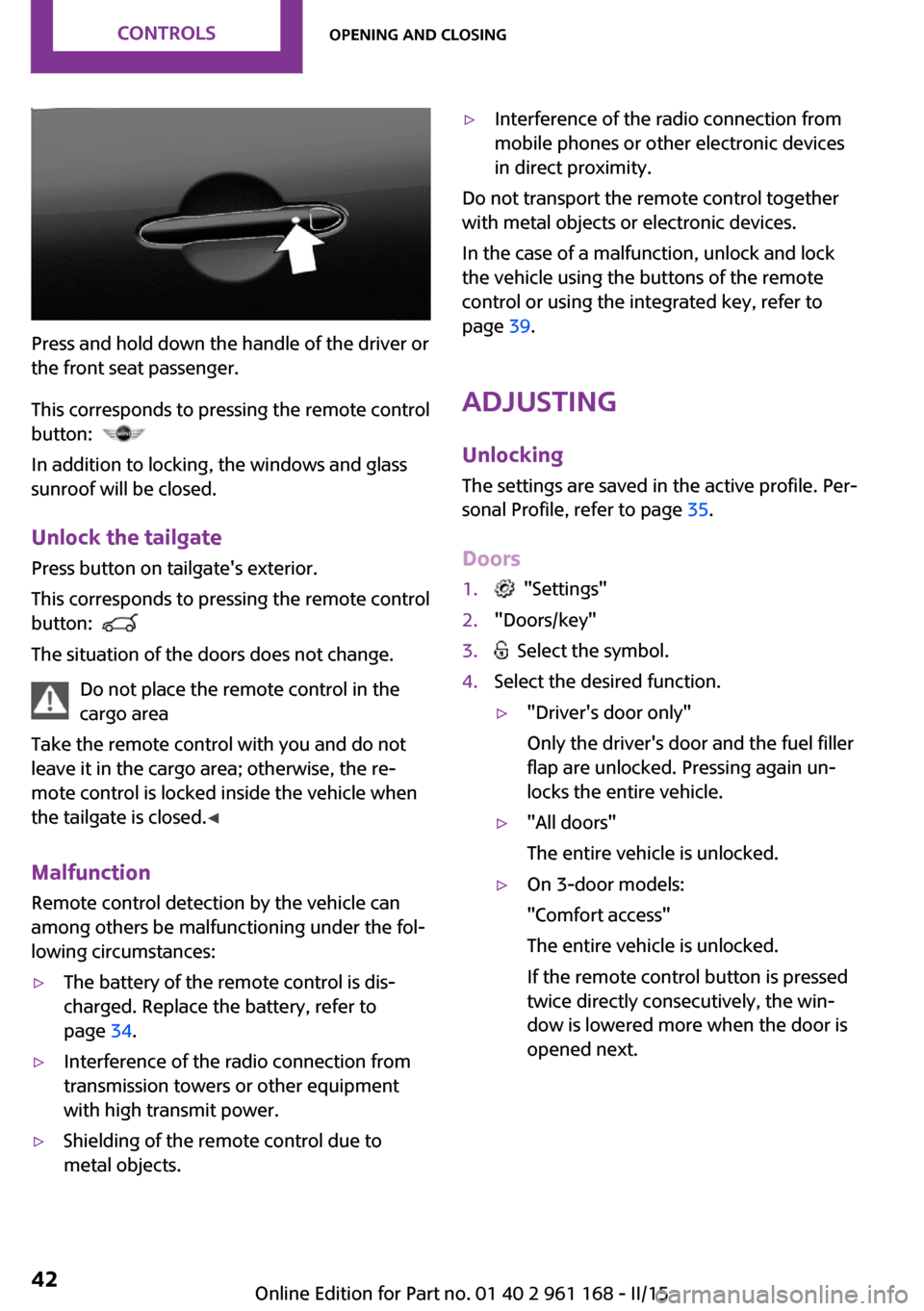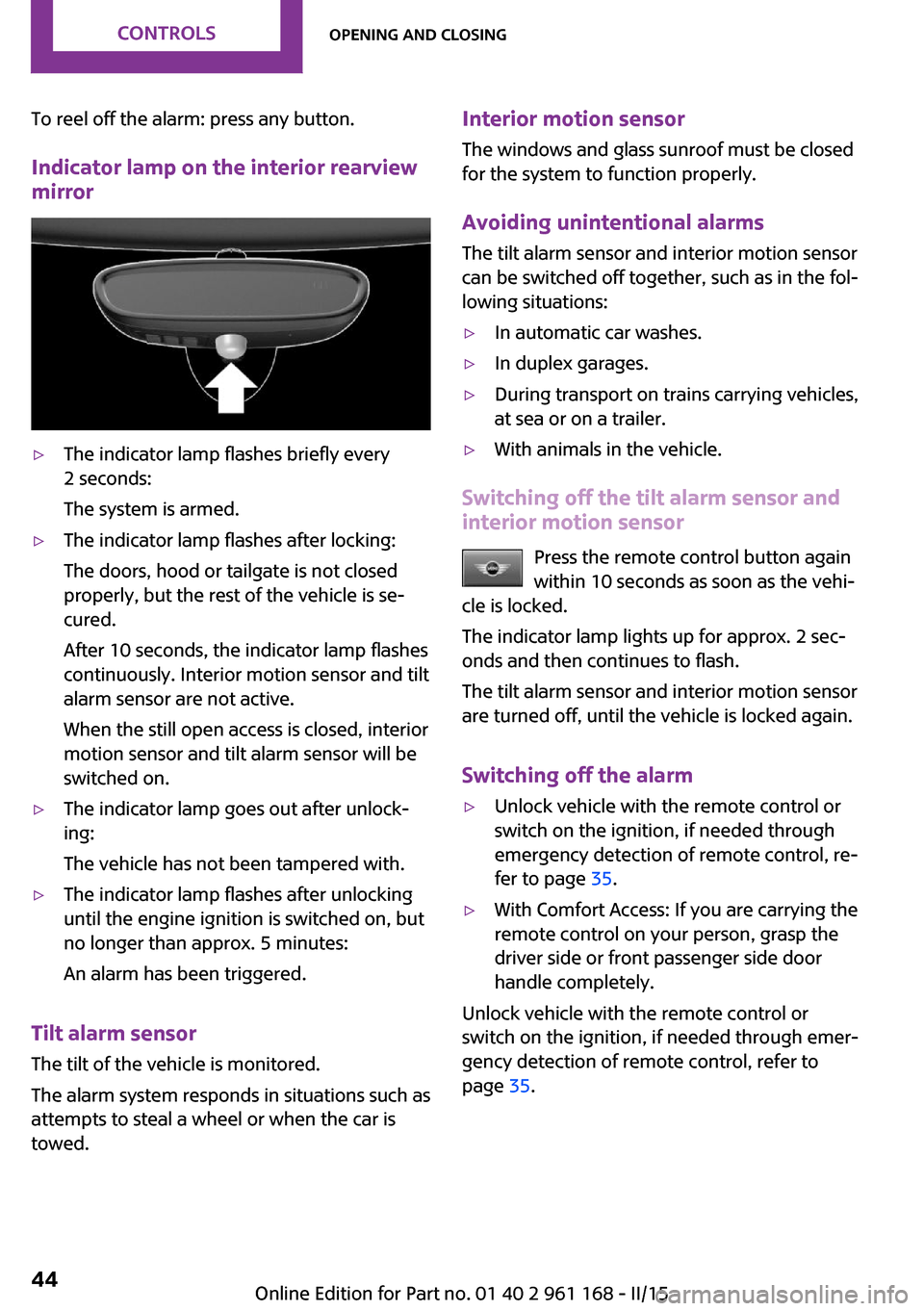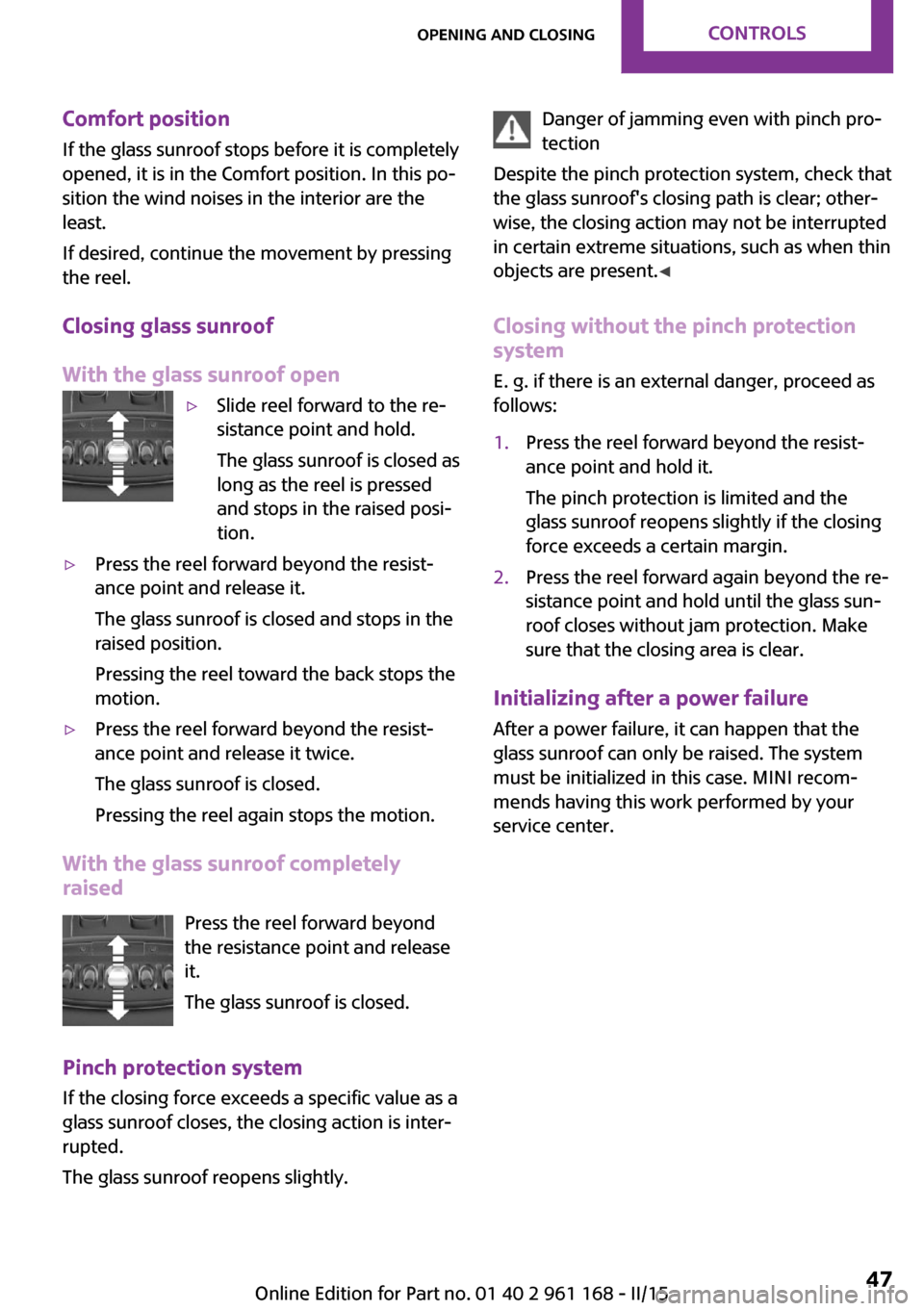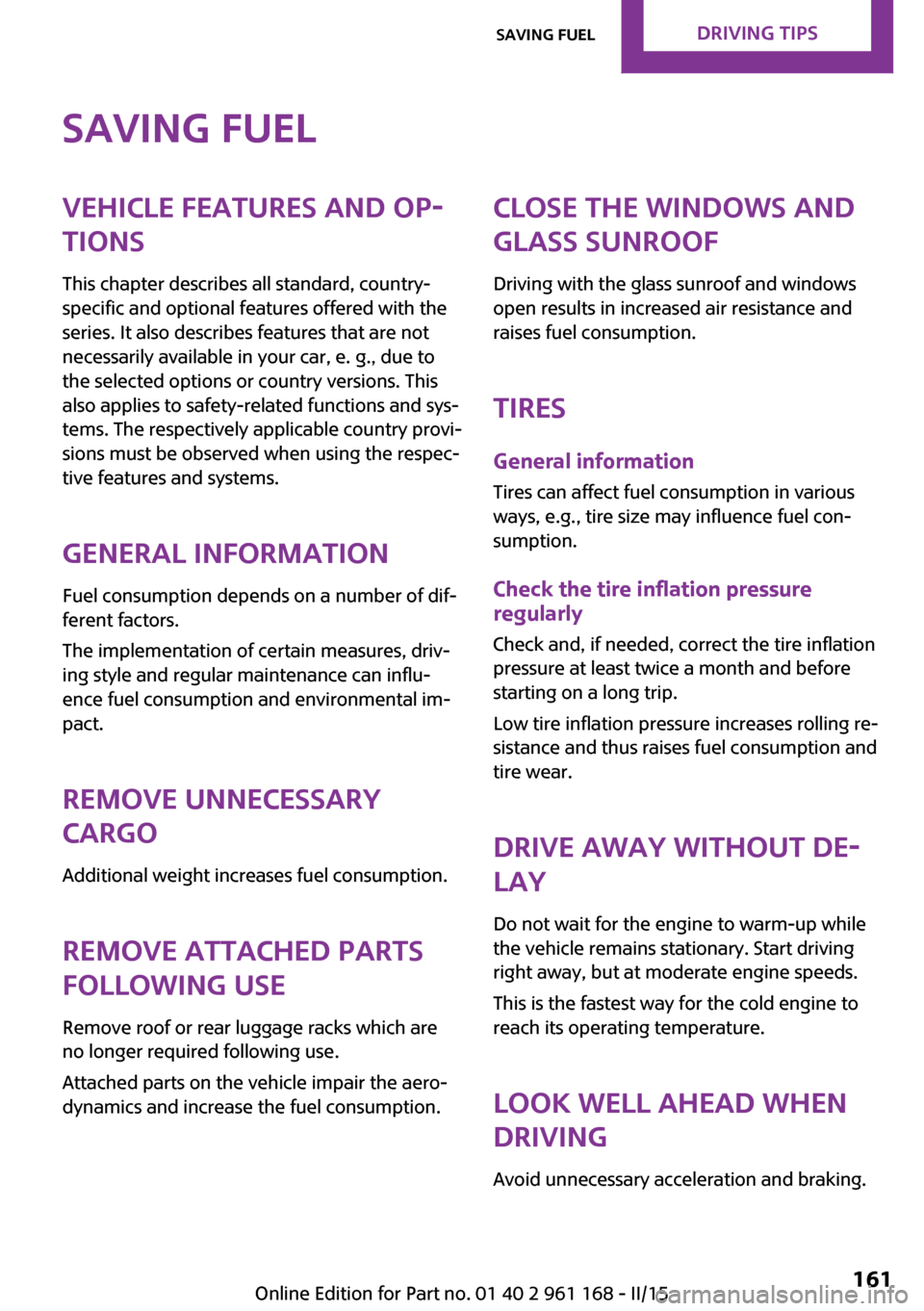sunroof MINI Hardtop 2 Door 2015 Owner's Manual (Mini Connected)
[x] Cancel search | Manufacturer: MINI, Model Year: 2015, Model line: Hardtop 2 Door, Model: MINI Hardtop 2 Door 2015Pages: 244, PDF Size: 11.11 MB
Page 21 of 244

All around the roofliner1Emergency Request2Indicator lamp, front-seat passen‚Äê
ger airbag‚ÄÇ‚ÄÖ 973Reading lights‚ÄÇ‚ÄÖ 944Ambient light‚ÄÇ‚ÄÖ945Glass sunroof‚ÄÇ‚ÄÖ466Interior lights‚ÄÇ‚ÄÖ93Seite 17CockpitAT A GLANCE17
Online Edition for Part no. 01 40 2 961 168 - II/15
Page 42 of 244

The alarm system, refer to page 43, is dis‚Äê
armed.
Convenient opening Press and hold this button on the re‚Äê
mote control after unlocking.
The windows and the glass sunroof are opened,
as long as the button on the remote control is
pressed.
Locking Locking from the outside
Do not lock the vehicle from the outside
with people inside the car, as the vehicle can‚Äê
not be unlocked from inside without special
knowledge. ‚óÄ
The driver's door must be closed. Press button on the remote control.
The alarm system, refer to page 43, is armed.
If the vehicle horn honks twice when you lock
the car, this means that the engine or ignition is
still switched on. In this case, the engine or ig‚Äê
nition must be switched off by means of the
Start/Stop button.
Switching on interior lights and
courtesy lights
Press button on the remote control
with the vehicle locked.
This function is not available, if the interior
lamps were switched off manually.
If the button is pressed within 10 seconds of
when the vehicle was locked Interior motion
sensor and tilt alarm sensor of the anti-theft
warning system, refer to page 44, are turned
off. After locking, wait 10 seconds before press‚Äê
ing the button again.Panic mode
You can trigger the alarm system if you find
yourself in a dangerous situation.
Press button on the remote control for
at least 3 seconds.
To switch off the alarm: press any button.
Unlock the tailgate Press button on the remote control for
approx. 1 second.
The tailgate opens slightly, regardless of whether the vehicle was previously locked or
unlocked.
Depending on the features and the country
version, it is also possible to have door un‚Äê
locked. Create the settings, refer to page 42.
If the doors were not unlocked, the tailgate is
locked again as soon as it closes.
Do not place the remote control in the
cargo area
Take the remote control with you and do not
leave it in the cargo area; otherwise, the re‚Äê
mote control is locked inside the vehicle when
the tailgate is closed. ‚óÄ
Provide edge protection
Sharp objects or those with edges can hit
the rear window while driving and damage the
heat conductors of the rear window. Provide edge protection. ‚óÄ
Malfunction Remote control detection by the vehicle can
among others be malfunctioning under the fol‚Äê
lowing circumstances:‚ñ∑The battery of the remote control is dis‚Äê
charged. Replace the battery, refer to
page 34.‚ñ∑Interference of the radio connection from
transmission towers or other equipment
with high transmit power.Seite 38CONTROLSOpening and closing38
Online Edition for Part no. 01 40 2 961 168 - II/15
Page 46 of 244

Press and hold down the handle of the driver or
the front seat passenger.
This corresponds to pressing the remote control
button:
In addition to locking, the windows and glass
sunroof will be closed.
Unlock the tailgate Press button on tailgate's exterior.
This corresponds to pressing the remote control
button:
The situation of the doors does not change.
Do not place the remote control in the
cargo area
Take the remote control with you and do not
leave it in the cargo area; otherwise, the re‚Äê
mote control is locked inside the vehicle when
the tailgate is closed. ‚óÄ
Malfunction Remote control detection by the vehicle can
among others be malfunctioning under the fol‚Äê
lowing circumstances:
‚ñ∑The battery of the remote control is dis‚Äê
charged. Replace the battery, refer to
page 34.‚ñ∑Interference of the radio connection from
transmission towers or other equipment
with high transmit power.‚ñ∑Shielding of the remote control due to
metal objects.‚ñ∑Interference of the radio connection from
mobile phones or other electronic devices
in direct proximity.
Do not transport the remote control together
with metal objects or electronic devices.
In the case of a malfunction, unlock and lock
the vehicle using the buttons of the remote
control or using the integrated key, refer to
page 39.
Adjusting Unlocking The settings are saved in the active profile. Per‚Äê
sonal Profile, refer to page 35.
Doors
1. "Settings"2."Doors/key"3. Select the symbol.4.Select the desired function.‚ñ∑"Driver's door only"
Only the driver's door and the fuel filler
flap are unlocked. Pressing again un‚Äê
locks the entire vehicle.‚ñ∑"All doors"
The entire vehicle is unlocked.‚ñ∑On 3-door models:
"Comfort access"
The entire vehicle is unlocked.
If the remote control button is pressed
twice directly consecutively, the win‚Äê
dow is lowered more when the door is
opened next.Seite 42CONTROLSOpening and closing42
Online Edition for Part no. 01 40 2 961 168 - II/15
Page 48 of 244

To reel off the alarm: press any button.
Indicator lamp on the interior rearview
mirror‚ñ∑The indicator lamp flashes briefly every
2 seconds:
The system is armed.‚ñ∑The indicator lamp flashes after locking:
The doors, hood or tailgate is not closed
properly, but the rest of the vehicle is se‚Äê
cured.
After 10 seconds, the indicator lamp flashes
continuously. Interior motion sensor and tilt
alarm sensor are not active.
When the still open access is closed, interior
motion sensor and tilt alarm sensor will be
switched on.‚ñ∑The indicator lamp goes out after unlock‚Äê
ing:
The vehicle has not been tampered with.‚ñ∑The indicator lamp flashes after unlocking
until the engine ignition is switched on, but
no longer than approx. 5 minutes:
An alarm has been triggered.
Tilt alarm sensor The tilt of the vehicle is monitored.
The alarm system responds in situations such as
attempts to steal a wheel or when the car is
towed.
Interior motion sensor
The windows and glass sunroof must be closed
for the system to function properly.
Avoiding unintentional alarms
The tilt alarm sensor and interior motion sensor
can be switched off together, such as in the fol‚Äê
lowing situations:‚ñ∑In automatic car washes.‚ñ∑In duplex garages.‚ñ∑During transport on trains carrying vehicles,
at sea or on a trailer.‚ñ∑With animals in the vehicle.
Switching off the tilt alarm sensor and
interior motion sensor
Press the remote control button again
within 10 seconds as soon as the vehi‚Äê
cle is locked.
The indicator lamp lights up for approx. 2 sec‚Äê
onds and then continues to flash.
The tilt alarm sensor and interior motion sensor
are turned off, until the vehicle is locked again.
Switching off the alarm
‚ñ∑Unlock vehicle with the remote control or
switch on the ignition, if needed through
emergency detection of remote control, re‚Äê
fer to page 35.‚ñ∑With Comfort Access: If you are carrying the
remote control on your person, grasp the
driver side or front passenger side door
handle completely.
Unlock vehicle with the remote control or
switch on the ignition, if needed through emer‚Äê
gency detection of remote control, refer to
page 35.
Seite 44CONTROLSOpening and closing44
Online Edition for Part no. 01 40 2 961 168 - II/15
Page 50 of 244

2.Pull the switch past the resistance point
again within approx. 4 seconds and hold it
there.
The window closes without jam protection.
On 5-door models: safety switch The safety switch in the driver's door can be
used to prevent children, e.g., from opening
and closing the rear windows using the
switches in the rear.
Switching on and off Press button.
The LED lights up if the safety function
is switched on.
Safety switch for rear operation
Press the safety switch when transporting
children in the rear; otherwise, injury may result
if the windows are closed without supervi‚Äê
sion. ‚óÄ
Panoramic glass sun‚Äê
roof
Hints Keep the closing path clear
Monitor closing and make sure that the
closing path of the glass sunroof is clear; other‚Äê
wise, injuries may result. ‚óÄ
Take the remote control with you
Take the remote control with you when
leaving the vehicle so that children, e.g., cannot
operate the glass sunroof and injure them‚Äê
selves. ‚óÄ
At a glance
Tilting the glass sunroof
Press back the reel up to or be‚Äê
yond the resistance point and re‚Äê
lease it.
The glass sunroof is raised.
Opening glass sunroof
When the glass sunroof is closed Press the reel back beyond the
resistance point and release it
twice.
The glass sunroof is opened.
Pressing the reel again stops the
motion.
With the glass sunroof completely
raised
‚ñ∑Slide reel back to the resist‚Äê
ance point and hold.
The glass sunroof is opened
as long as the reel is pressed.‚ñ∑Press the reel back beyond
the resistance point and re‚Äê
lease it.
The glass sunroof is opened.
Pressing the reel again stops
the motion.Seite 46CONTROLSOpening and closing46
Online Edition for Part no. 01 40 2 961 168 - II/15
Page 51 of 244

Comfort position
If the glass sunroof stops before it is completely
opened, it is in the Comfort position. In this po‚Äê
sition the wind noises in the interior are the
least.
If desired, continue the movement by pressing
the reel.
Closing glass sunroof
With the glass sunroof open‚ñ∑Slide reel forward to the re‚Äê
sistance point and hold.
The glass sunroof is closed as
long as the reel is pressed
and stops in the raised posi‚Äê
tion.‚ñ∑Press the reel forward beyond the resist‚Äê
ance point and release it.
The glass sunroof is closed and stops in the
raised position.
Pressing the reel toward the back stops the
motion.‚ñ∑Press the reel forward beyond the resist‚Äê
ance point and release it twice.
The glass sunroof is closed.
Pressing the reel again stops the motion.
With the glass sunroof completely
raised
Press the reel forward beyond
the resistance point and release
it.
The glass sunroof is closed.
Pinch protection system If the closing force exceeds a specific value as a
glass sunroof closes, the closing action is inter‚Äê
rupted.
The glass sunroof reopens slightly.
Danger of jamming even with pinch pro‚Äê
tection
Despite the pinch protection system, check that
the glass sunroof's closing path is clear; other‚Äê
wise, the closing action may not be interrupted
in certain extreme situations, such as when thin
objects are present. ‚óÄ
Closing without the pinch protection
system
E. g. if there is an external danger, proceed as
follows:1.Press the reel forward beyond the resist‚Äê
ance point and hold it.
The pinch protection is limited and the
glass sunroof reopens slightly if the closing
force exceeds a certain margin.2.Press the reel forward again beyond the re‚Äê
sistance point and hold until the glass sun‚Äê
roof closes without jam protection. Make
sure that the closing area is clear.
Initializing after a power failure
After a power failure, it can happen that the
glass sunroof can only be raised. The system
must be initialized in this case. MINI recom‚Äê
mends having this work performed by your
service center.
Seite 47Opening and closingCONTROLS47
Online Edition for Part no. 01 40 2 961 168 - II/15
Page 159 of 244

‚ñ∑Close all windows and the glass sunroof.‚ñ∑Greatly increase the air flow from the vents.‚ñ∑Drive moderately.
Hot exhaust systemHot exhaust system
High temperatures are generated in the
exhaust system.
Do not remove the heat shields installed and
never apply undercoating to them. Make sure
that flammable materials, e. g. hay, leaves,
grass, etc. do not come in contact with the hot
exhaust system while driving, while in idle posi‚Äê
tion mode, or when parked. Such contact could
lead to a fire, resulting in an increased risk of
serious personal injury as well as property dam‚Äê
age.
Do not touch hot exhaust pipes; otherwise,
there is a danger of getting burned. ‚óÄ
Mobile communication devices in the
vehicle
Mobile communication devices in the ve‚Äêhicle
It is not recommended to use mobile phones,
such as mobile phones, in the vehicle interior
without a direct connection to an external aer‚Äê
ial. Otherwise, the vehicle's electronics and mo‚Äê
bile communication devices can interfere with
each other. In addition, there is no assurance
that the radiation generated during transmis‚Äê
sion will be conducted away from the vehicle
interior. ‚óÄ
Hydroplaning Hydroplaning
When driving on wet or slushy roads, re‚Äê
duce your speed to prevent hydroplaning. ‚óÄ
On wet or slushy roads, a wedge of water can
form between the tires and road surface.
This phenomenon is referred to as hydroplan‚Äê
ing. It is characterized by a partial or complete
loss of contact between the tires and the road
surface, ultimately undermining your ability to
steer and brake the vehicle.
Driving through water Observe water level and speed
Do not exceed the maximum water level
and maximum speed; otherwise, the vehicle's
engine, the electrical systems and the transmis‚Äê
sion may be damaged. ‚óÄ
Drive through calm water only if it is not deeper
than 9.8 inches/25 cm and at this height, no
faster than walking speed, up to 3 mph/5 km/h.
Braking safely Your vehicle is equipped with ABS as a standard
feature.
Applying the brakes fully is the most effective
way of braking in situations needed.
Steering is still responsive. You can still avoid
any obstacles with a minimum of steering ef‚Äê
fort.
Pulsation of the brake pedal and sounds from
the hydraulic circuits indicate that ABS is in its
active mode.
Objects in the area around the pedals No objects in the area around the pedals
Keep floor mats, carpets, and any other
objects out of the pedal area; otherwise, the
function of the pedals could be impeded while
driving and create the risk of an accident.
Do not place additional floor mats over existing
mats or other objects.
Only use floor mats that have been approved
for the vehicle and can be properly attached to
floor.
Ensure that the floor mats are securely fastened
again after they were removed for cleaning,
e.g. ‚óÄSeite 155Things to remember when drivingDRIVING TIPS155
Online Edition for Part no. 01 40 2 961 168 - II/15
Page 163 of 244

Securing
Follow the installation instructions of the roof
rack.
Loading Be sure that adequate clearance is maintained
for tilting and opening the glass sunroof.
Because roof racks raise the vehicle's center of
gravity when loaded, they have a major effect
on vehicle handling and steering response.
Therefore, note the following when loading and
driving:‚ñ∑Do not exceed the approved roof/axle
loads and the approved gross vehicle
weight.‚ñ∑Distribute the roof load uniformly.‚ñ∑The roof load should not extend past the
loading area.‚ñ∑Always place the heaviest pieces on the
bottom.‚ñ∑Secure the roof luggage firmly, e.g., tie with
ratchet straps.‚ñ∑Do not let objects project into the opening
path of the tailgate.‚ñ∑Drive cautiously and avoid sudden acceler‚Äê
ation and braking maneuvers. Take corners
gently.
Rear luggage rack
General information Installation only possible with rear luggage rack
preparation.
Rear racks are available as special accessories.
Note Follow the installation instructions of the rear
luggage rack.
Drive cautiously and avoid sudden acceleration
and braking maneuvers. Take corners gently.
SecuringCOOPER/COOPER D/ONE/ONE DCOOPER S/COOPER SD
The anchorage points, arrow 1, and the socket,
arrow 2, are located below the covers in the
bumper.
Remove the covers before installing the rear
luggage rack.
Power consumption Function of tail lights
Before driving off, check that the tail
lights of the rear luggage rack are functioning
properly; otherwise, there is a risk of endanger‚Äê
ing other traffic. ‚óÄ
The rear luggage rack lights must not consume
more than:
‚ñ∑Turn signals: 42 watts per side.‚ñ∑Rear lights: 50 watts per side.‚ñ∑Brake lights: 84 watts in total.‚ñ∑Rear fog lights: 42 watts in total.Seite 159LoadingDRIVING TIPS159
Online Edition for Part no. 01 40 2 961 168 - II/15
Page 165 of 244

Saving fuelVehicle features and op‚Äêtions
This chapter describes all standard, country-
specific and optional features offered with the
series. It also describes features that are not necessarily available in your car, e. g., due to
the selected options or country versions. This
also applies to safety-related functions and sys‚Äê
tems. The respectively applicable country provi‚Äê
sions must be observed when using the respec‚Äê
tive features and systems.
General information Fuel consumption depends on a number of dif‚Äê
ferent factors.
The implementation of certain measures, driv‚Äê
ing style and regular maintenance can influ‚Äê
ence fuel consumption and environmental im‚Äê
pact.
Remove unnecessary
cargo
Additional weight increases fuel consumption.
Remove attached parts
following use
Remove roof or rear luggage racks which are
no longer required following use.
Attached parts on the vehicle impair the aero‚Äê
dynamics and increase the fuel consumption.Close the windows and
glass sunroof
Driving with the glass sunroof and windows
open results in increased air resistance and
raises fuel consumption.
Tires
General information Tires can affect fuel consumption in various
ways, e.g., tire size may influence fuel con‚Äê
sumption.
Check the tire inflation pressure
regularly
Check and, if needed, correct the tire inflation
pressure at least twice a month and before
starting on a long trip.
Low tire inflation pressure increases rolling re‚Äê
sistance and thus raises fuel consumption and
tire wear.
Drive away without de‚Äê
lay
Do not wait for the engine to warm-up while
the vehicle remains stationary. Start driving
right away, but at moderate engine speeds.
This is the fastest way for the cold engine to
reach its operating temperature.
Look well ahead when
driving
Avoid unnecessary acceleration and braking.Seite 161Saving fuelDRIVING TIPS161
Online Edition for Part no. 01 40 2 961 168 - II/15
Page 218 of 244

CareVehicle features and op‚Äêtions
This chapter describes all standard, country-
specific and optional features offered with the series. It also describes features that are not
necessarily available in your car, e. g., due to
the selected options or country versions. This
also applies to safety-related functions and sys‚Äê
tems. The respectively applicable country provi‚Äê
sions must be observed when using the respec‚Äê
tive features and systems.
Car washes
General information Regularly remove foreign objects such as leaves
in the area below the windshield when the
hood is raised.
Wash your vehicle frequently, particularly in
winter. Intense soiling and road salt can dam‚Äê
age the vehicle.
Hints Steam jets or high-pressure washers
When using steam jets or high-pressure
washers, hold them a sufficient distance away
and use a maximum temperature of
140 ‚Ñâ/60 ‚ÑÉ.
If the vehicle has a glass sunroof, ensure that a
distance of at least 31.5 inches/80 cm is main‚Äê
tained. Holding them too close or using exces‚Äê
sively high pressures or temperatures can
cause damage or preliminary damage that may
then lead to long-term damage.
Follow the user's manual for the high-pressure
washer. ‚óÄCleaning sensors/camera lenses with
high-pressure washers
When using high-pressure washers, do not
spray the sensors and camera lenses on the
outside of the vehicle for long periods and
maintain a distance of at least 12 in/30 cm. ‚óÄ
Automatic car washes
Hints‚ñ∑Give preference to cloth car washes or
those that use soft brushes in order to
avoid paint damage.‚ñ∑Make sure that the wheels and tires are not
damaged by the transport mechanisms.‚ñ∑Fold in the exterior mirrors; otherwise, they
may be damaged, depending on the width
of the vehicle.‚ñ∑Unscrew the rod antenna.‚ñ∑Deactivate the rain sensor, refer to
page 66, to avoid unintentional wiper acti‚Äê
vation.‚ñ∑In some cases, an unintentional alarm can
be triggered by the interior motion sensor
of the alarm system. Follow the instructions
on avoiding an unintentional alarm, refer to
page 44.
Guide rails in car washes
Avoid car washes with guide rails higher
than 4 in/10 cm; otherwise, the vehicle body
could be damaged. ‚óÄ
Before driving into a car wash In order to ensure that the vehicle can roll in a
car wash, take the following steps:
Manual transmission:
1.Drive into the car wash.2.Shift to neutral.Seite 214MOBILITYCare214
Online Edition for Part no. 01 40 2 961 168 - II/15